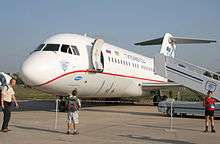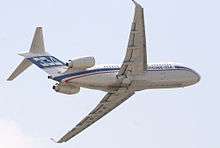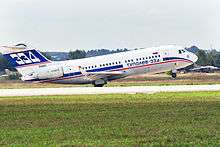Tupolev Tu-334
| Tu-334 | |
|---|---|
 | |
| At the 2007 MAKS Airshow | |
| Role | Narrow-body jet airliner |
| National origin | Russia |
| Manufacturer | United Aircraft Corporation |
| First flight | February 8, 1999 |
| Status | Cancelled |
| Produced | 1999–2009 |
| Number built | 2 |
| Program cost | about $1 billion |
| Unit cost |
$16 million $43–44 million (Business version) |
| Developed from | Tupolev Tu-204 |



The Tupolev Tu-334 was a Russian short to medium range airliner project that was developed to replace the ageing Tu-134s and Yak-42s in service around the world. The airframe was based on a shortened Tu-204 fuselage and a scaled-down version of that aircraft's wing. Unlike the Tu-204, however, the Tu-334 has a T-tail and engines mounted on the sides of the rear fuselage instead of under the wings. With the rationalisation of the Russian aircraft companies in 2009 to form United Aircraft Corporation it was decided not to continue with the programme.[1]
Development
Work commenced on the Tu-334 in the early 1990s, but proceeded slowly due to funding problems arising from the break-up of the Soviet Union. A prototype was displayed in 1995, but this was little more than a mock-up with few systems installed. A functional aircraft first flew on February 8, 1999, and later that year, agreements were put in place for MiG to undertake part of the production of the airliner. A Russian type certificate was obtained – after some delay – on December 30, 2003.[2]
Since then, development remained slow due to protracted budget problems. In turn, the certification of the aircraft and its planned entry into serial production was delayed multiple times. As of December 2006 there were firm orders for the Tupolev Tu-334 from seven airlines, including Atlant-Soyuz Airlines and there were letters of intent from 24 airlines to obtain another 297 airplanes.[3][4] Price per unit for the business version is estimated to be around $43–44 million.[5]
One of the projected customers for the type was Iran. The Iran Aviation Industries Organization (IAIO) was in negotiations to purchase licenses to assemble the aircraft in Iran by 2011 and manufacture them completely by 2015 alongside Tu-214.[6] Nothing concrete became of these negotiations before the cancellation of the Tu-334 programme.
As late as 2008, Tupolev reported that a total of about 100 airlines had expressed an interest in placing orders for Tu-334s; on July 31, 2008, Tupolev Managing Director Sergei Ilyushenkov announced that production was targeted to begin no later than January 2009.[5] However, this date also passed without any reported progress on Tu-334 serial production.
In 2009, with the project years behind the projected schedule and only two examples built and flying ten years after first flight, the Tu-334 came under review during the rationalisation of the Russian aircraft companies, which led to the formation of United Aircraft Corporation. In mid-2009, the decision was taken to not continue with the Tu-334 programme and instead focus efforts on the Sukhoi Superjet 100, the Antonov An-148, and the Irkut MC-21.[1]
Variants
- Tu-334-100
- Basic version, with accommodation for 72 passengers in mixed-class configuration (12 first-class and 60 tourist-class) or 102 passengers in high-density layout. Two 73.6 kN (16,500 lbf) Progress D-436T1 turbofans.[7]
- Tu-334-100C
- Proposed combi (passenger/freight) version of Tu-334-100.[7]
- Tu-334-120
- Planned derivative of Tu-334-100, powered by two 88.9 kN (20,000 lbf) Rolls-Royce BR715-55 engines.[7]
- Tu-334-100D
- Planned stretched, extended-range version. Fuselage stretched by 54 cm (21 in) and longer span (32.61 m (107 ft 0 in)) wing. Powered by two 80.4 kN (18,100 lbf) Progress D-436T2 engines.[8]
- Tu-334-120D
- Based on Tu-334-100D, but with two Rolls-Royce BR-715-55 engines.[7]
- Tu-336
- Proposed liquid natural gas-fueled version, with cryogenic fuel tanks above passenger cabin.[7]
- Tu-354
- Further stretched version, originally designated Tu-334-200. Stretched by 390 cm (150 in) over Tu-334-100, with accommodation for up to 126 passengers. Powered by two Progress D-436T2 or Rolls-Royce BR-715-55 engines, the Tu-354's landing gear was strengthened to use four-wheel bogies.[8]
Specifications (Tu-334-100)
Data from Jane's All The World's Aircraft 2003–2004[8]
General characteristics
- Crew: 2–3
- Capacity: 102 passengers (tourist-class, 81 cm (32 in) seat pitch)
- Length: 31.26 m (102 ft 7 in)
- Wingspan: 29.77 m (97 ft 8 in)
- Height: 9.38 m (30 ft 9 in)
- Wing area: 83.23 m2 (895.9 sq ft)
- Empty weight: 28,950 kg (63,824 lb)
- Max takeoff weight: 47,900 kg (105,601 lb)
- Powerplant: 2 × Progress D-436T1 turbofan, 73.6 kN (16,500 lbf) thrust each
Performance
- Cruising speed: 820 km/h (510 mph; 443 kn) at 10,600–11,100 m (34,800–36,400 ft)
- Range: 3,150 km (1,957 mi; 1,701 nmi)
See also
- Related development
- Aircraft of comparable role, configuration and era
- Related lists
References
- Citations
- 1 2 Daly, Kieran (August 11, 2009). "Russia's United Aircraft reaches maturity". Flightglobal. Retrieved January 9, 2016.
- ↑ Tupolev: News 2003/2004
- ↑ Flight International, 3–9 October 2006
- ↑ Roy Cochrun. "Roy's Russian Aircraft Resource".
- 1 2 "Russia to launch production of Tu-334 airliner within 6 months". RIA Novosti. July 31, 2008. Retrieved 2008-07-31.
- ↑ John Pike. "Tu-334".
- 1 2 3 4 5 Jackson 2003, p. 432.
- 1 2 3 Jackson 2003, pp. 432–433.
- Bibliography
- Gordon, Yefim; Rigamant, Vladimir (2005). OKB Tupolev: A History of the Design Bureau and its Aircraft. Hinckley, England: Midland Publishing. ISBN 1-85780-214-4.
- Jackson, Paul, ed. (2003). Jane's All The World's Aircraft 2003–2004. Coulsdon, UK: Jane's Information Group. ISBN 0-7106-2537-5.
External links
![]() Media related to Tupolev Tu-334 at Wikimedia Commons
Media related to Tupolev Tu-334 at Wikimedia Commons